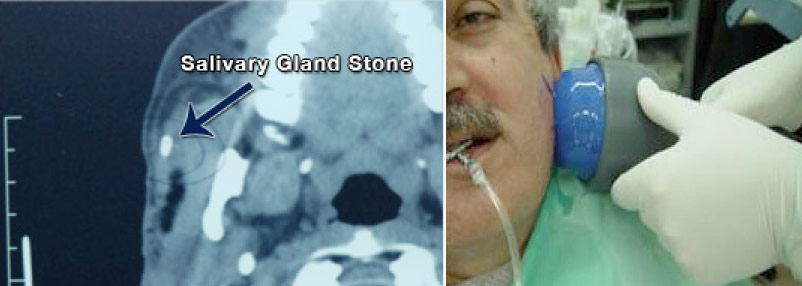- India Medical Mission 2018 - November 1, 2018
- Sleep Disorders: Sleep Apnea and Upper Stimulation Therapy - August 25, 2015
- The Naked Vocalist Podcast Featuring Dr. Reena Gupta - May 27, 2015
- New Therapy for Sleep Apnea – First Sleep Pacemaker placed in California at Osborne Head and Neck Institute. - December 12, 2014
- Boxer’s Ear: Can your ear explode? - December 12, 2014
- Nose Picking (Rhinotillexis) and Septal Perforations: Why I should stop picking my nose…? - November 24, 2014
- Deviated Septum and Septal Perforation - July 28, 2014
- Hereditary Hemorrhagic Telangiectasia: Nasal Septal Perforation Repair - June 25, 2014
- Dr. Mantle recognized at the Beverly Hills Medical Science Academy Awards - May 8, 2014
- Commonly Misdiagnosed Pathologies: Arteriovenous Malformations - April 9, 2014
Is lithotripsy an option for the treatment of salivary stones?
Question: My ENT doctor diagnosed me with “sialolithiasis”, a salivary gland stone. Before my diagnosis, I periodically noticed that I had a drier mouth than usual. I also started to develop swelling and pain in my lower jaw. During my evaluation my doctor pointed out that a stone was blocking the normal flow of saliva into my mouth and that it was “impacted” and too large to be removed by conventional means. My doctor’s recommendation is that I should have the salivary duct and gland surgically removed. I have heard of lithotripsy as a means of treating large stones elsewhere within the body. Is lithotripsy an option for the treatment of my salivary gland stones?

Right – Lithotripsy patient undergoing procedure.
Discussion:
Currently there are three main options for treatment of salivary gland stones: lithotripsy, surgery, and sialendoscopy.
Lithotripsy is a procedure which utilizes targeted sound waves in order to fragment stones so that a patient may pass them naturally. This procedure is considered experimental and is utilized with varying amounts of success in parts of Europe. The FDA has not currently approved lithotripsy for use in the United States due to concerns over efficacy and potential complications. In many cases stone fragmentation is incomplete and large pieces of the stone remain in the duct causing continued obstruction and potentially leading to complications most commonly hematoma and infection that may necessitate surgical removal of the gland.
Historically surgical gland removal (sialadenectomy) was the gold-standard for removal of large stones that have become impacted within the salivary gland. In order to remove the stone the surgeon typically removes the duct and/or the entire salivary gland thereby permanently treating the diseased gland. Because of the intimate relationship of nerves fibers coursing within and around the salivary glands, surgical removal can have dramatic complications such as facial paralysis, loss of taste, and altered oral sensation.

Right: Salivary stone after removal.
Currently the new gold-standard for the treatment of salivary gland stones is sialendoscopy. Dr. Ryan Osborne, Director of Head and Neck Surgery at Osborne Head and Neck Institute has advanced the use of sialendoscopy for the removal of salivary gland stones. Sialendoscopy uses a very thin and flexible endoscope which is carefully passed through the salivary gland’s natural opening, located in the mouth. This instrument allows the doctor to visualize the health of the gland, locate stones, and completely remove them without harming any of the surrounding tissue. Sialendoscopy avoids common risks and complications seen with lithotripsy and surgery such as scarring, nerve damage, bleeding; loss of taste and oral sensation; and increased recovery time. Given the low risk and excellent success rate of sialendoscopy, we currently recommend it for the removal of all salivary gland stones over other procedures such as lithotripsy and surgical intervention.
Key Points:
- Definition: Sialolithiasis is the technical name for stones which have formed in the salivary gland ducts.
- Symptoms: Sialolithiasis can present with dry mouth, coarse textured saliva and facial and neck pain.
- Treatment Option: Treatments of salivary gland stones include lithotripsy, surgical excision, and sialendoscopy. Lithotripsy is not currently approved for use in the United States. Sialendoscopy utilizes a thin endoscope which is passed through the glands natural opening in the mouth; is minimally invasive; and preserves surrounding tissues including those of the glands and nerves.
- Recommendations: We currently recommend sialendoscopy as treatment for salivary gland stones due to its minimally invasive nature, success rate, and decreased recuperation time.



